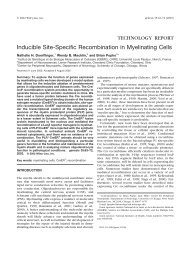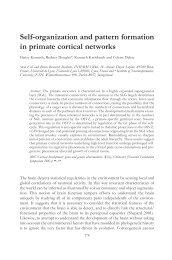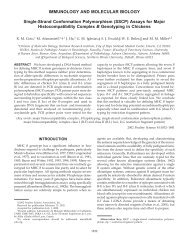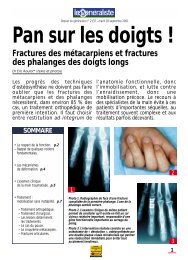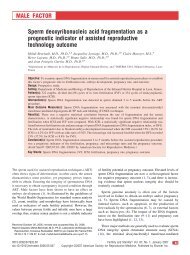Reward anticipation, cognition, and electrodermal activity in the ...
Reward anticipation, cognition, and electrodermal activity in the ...
Reward anticipation, cognition, and electrodermal activity in the ...
You also want an ePaper? Increase the reach of your titles
YUMPU automatically turns print PDFs into web optimized ePapers that Google loves.
Exp Bra<strong>in</strong> Res (2003) 149:267–275<br />
DOI 10.1007/s00221-002-1353-9<br />
RESEARCH ARTICLE<br />
CØl<strong>in</strong>e Amiez · Emmanuel Procyk · Jacques HonorØ ·<br />
Henrique Sequeira · Jean-Paul Joseph<br />
<strong>Reward</strong> <strong>anticipation</strong>, <strong>cognition</strong>, <strong>and</strong> <strong>electrodermal</strong> <strong>activity</strong><br />
<strong>in</strong> <strong>the</strong> conditioned monkey<br />
Received: 5 June 2002 / Accepted: 15 November 2002 / Published onl<strong>in</strong>e: 14 February 2003<br />
Spr<strong>in</strong>ger-Verlag 2003<br />
Abstract In <strong>the</strong> present report, we exam<strong>in</strong>e <strong>electrodermal</strong><br />
<strong>activity</strong> (sk<strong>in</strong> conductance responses, SCRs) <strong>in</strong> monkeys<br />
tra<strong>in</strong>ed to perform target-selection (TS) tests. In each test,<br />
<strong>the</strong> animal was presented <strong>in</strong> successive trials with <strong>the</strong><br />
same two unequally rewarded targets on a touch screen.<br />
The probabilistic cont<strong>in</strong>gencies of <strong>the</strong> rewards associated<br />
with each target rendered <strong>the</strong> selection of <strong>the</strong> best<br />
difficult. Our f<strong>in</strong>d<strong>in</strong>gs revealed SCRs time-locked to <strong>the</strong><br />
arm movements toward <strong>the</strong> rewarded targets, occurr<strong>in</strong>g<br />
after <strong>the</strong> target touches. Parameters of <strong>the</strong> SCRs were<br />
stable when <strong>the</strong> uncerta<strong>in</strong>ty of <strong>the</strong> choices <strong>and</strong> of <strong>the</strong><br />
outcomes varied. The results support <strong>the</strong> hypo<strong>the</strong>sis that<br />
<strong>the</strong> physiological processes <strong>in</strong>dexed by <strong>the</strong> SCRs are <strong>the</strong><br />
correlate of anticipatory appetitive behavior. In contrast,<br />
<strong>the</strong>re is no evidence that <strong>the</strong> SCRs reflect cognitive<br />
processes associated with <strong>the</strong> detection of <strong>the</strong> best target.<br />
Keywords Target selection · Sk<strong>in</strong> conductance<br />
responses · Electrodermal <strong>activity</strong> · <strong>Reward</strong> <strong>anticipation</strong> ·<br />
Rhesus monkey<br />
Introduction<br />
The capacity to anticipate <strong>and</strong> to <strong>in</strong>ternally simulate <strong>the</strong><br />
positive or negative consequences of action is a decisive<br />
aspect of behavior. This capacity allows us to <strong>in</strong>teract<br />
more effectively with <strong>the</strong> environment <strong>and</strong>, if necessary,<br />
to modify our course of action. It is a fundamental<br />
condition of adaptive behaviors <strong>in</strong> complex or ambiguous<br />
environments.<br />
C. Amiez ()) · E. Procyk · J.-P. Joseph<br />
Institut FØdØratif des Neurosciences de Lyon,<br />
Inserm U371, 18 ave Doyen Lep<strong>in</strong>e, 69675 Bron, France<br />
e-mail: amiez@lyon151.<strong>in</strong>serm.fr<br />
Tel.: +33-4-72913494<br />
Fax: +33-4-729134 61<br />
J. HonorØ · H. Sequeira<br />
Laboratoire de Neurosciences du Comportement,<br />
UniversitØ de Lille I, SN4.1, 59655 Villeneuve d’Ascq Cedex,<br />
France<br />
Expectation <strong>and</strong> motor preparation can be launched by<br />
external or <strong>in</strong>ternal signals <strong>and</strong> are thought to require<br />
autonomic adjustments (Routtenberg 1968; Pribram <strong>and</strong><br />
McGu<strong>in</strong>ness 1975). Electrodermal <strong>activity</strong> (sk<strong>in</strong> conductance<br />
responses, SCRs) is considered to reflect such<br />
adaptive mechanisms, anticipat<strong>in</strong>g <strong>the</strong> occurrence of a<br />
significant event (Boucse<strong>in</strong> 1992), i.e., an event of <strong>in</strong>terest<br />
for <strong>the</strong> organism because of its uncerta<strong>in</strong>ty or its<br />
motivational value (reward or punishment).<br />
The <strong>anticipation</strong> l<strong>in</strong>ked to an external signal has been<br />
<strong>in</strong>vestigated <strong>in</strong> many studies devoted to classical condition<strong>in</strong>g.<br />
In this paradigm, <strong>the</strong> unconditioned stimulus is<br />
<strong>in</strong>itially followed by SCR changes. As <strong>the</strong> condition<strong>in</strong>g<br />
progresses <strong>and</strong> <strong>the</strong> neutral stimulus acquires a conditional<br />
value, such changes come to anticipate <strong>the</strong> imm<strong>in</strong>ent<br />
unconditioned stimulus. Consider<strong>in</strong>g that movement is<br />
known to <strong>in</strong>fluence SCRs (Culp <strong>and</strong> Edelberg 1966;<br />
Edelberg 1970; Siddle et al. 1979), <strong>the</strong> possibility that an<br />
action generat<strong>in</strong>g reward can be accompanied by specific<br />
SCR changes rema<strong>in</strong>s an open issue.<br />
The aim of <strong>the</strong> present study was to <strong>in</strong>vestigate for <strong>the</strong><br />
first time SCRs <strong>in</strong> a rewarded cognitive task <strong>in</strong> nonhuman<br />
primates. We show that SCRs precede foodreward<br />
delivery at <strong>the</strong> time of arm movements. We also<br />
<strong>in</strong>vestigate possible alterations of SCRs <strong>in</strong> <strong>cognition</strong>.<br />
Materials <strong>and</strong> methods<br />
Two male rhesus monkeys (monkeys E <strong>and</strong> N) were used <strong>in</strong> this<br />
experiment. They were orig<strong>in</strong>ally prepared for extracellular electrophysiological<br />
unit record<strong>in</strong>gs. In monkey E, <strong>the</strong> SCRs were<br />
<strong>in</strong>vestigated dur<strong>in</strong>g a pause <strong>in</strong> <strong>the</strong> neuronal record<strong>in</strong>gs. When <strong>the</strong><br />
record<strong>in</strong>g began, <strong>the</strong> animal had been tra<strong>in</strong>ed <strong>in</strong> <strong>the</strong> tasks for<br />
2 years. In monkey N, which had been tra<strong>in</strong>ed for 4 months, <strong>the</strong><br />
neuronal record<strong>in</strong>gs had not yet begun. Monkey E worked with <strong>the</strong><br />
left h<strong>and</strong>, while monkey N worked with <strong>the</strong> right h<strong>and</strong>. Monkey E<br />
worked head-fixed; monkey N worked head-free. In <strong>the</strong> two<br />
monkeys, surgical procedures were carried out accord<strong>in</strong>g to <strong>the</strong><br />
1986 European Communities Council Directive (M<strong>in</strong>ist›re de<br />
l’Agriculture et de la ForÞt, Commission Nationale de l’ExpØrimentation<br />
Animale).<br />
The animal was seated <strong>in</strong> a primate chair <strong>in</strong> front of a tangent<br />
touch-screen (Microtouch System) coupled to a TV monitor. The
268<br />
Fig. 1a, b Display <strong>and</strong> trial events <strong>in</strong> <strong>the</strong> target-selection (TS) task,<br />
<strong>in</strong> control tasks C1, C2, <strong>and</strong> C3 (a) <strong>and</strong> <strong>in</strong> <strong>the</strong> sequence task (b).<br />
Location of <strong>the</strong> two target positions on <strong>the</strong> display monitor. A 2”2<br />
cm square located 10 cm below ei<strong>the</strong>r one (r<strong>and</strong>omly, 50/50) of <strong>the</strong><br />
two targets served as start<strong>in</strong>g position of <strong>the</strong> h<strong>and</strong> (SP; <strong>the</strong> left SP is<br />
represented). Gray areas correspond to <strong>the</strong> time of illum<strong>in</strong>ation of<br />
<strong>the</strong> lever <strong>and</strong> of <strong>the</strong> targets. Arrows <strong>in</strong>dicate <strong>the</strong> responses of <strong>the</strong><br />
animal. See Materials <strong>and</strong> methods section<br />
screen was located at arm’s length. In <strong>the</strong> front panel of <strong>the</strong> chair,<br />
an arm-projection w<strong>in</strong>dow was opened, which allowed <strong>the</strong> monkey<br />
to touch <strong>the</strong> screen with one h<strong>and</strong>. Ano<strong>the</strong>r smaller w<strong>in</strong>dow was<br />
opened at <strong>the</strong> level of <strong>the</strong> nonperform<strong>in</strong>g h<strong>and</strong> to record SCRs. A<br />
computer recorded <strong>the</strong> position <strong>and</strong> correctness of each touch. It<br />
also controlled <strong>the</strong> presentation on <strong>the</strong> monitor of visual stimuli<br />
(colored shapes), which served as light-targets (CORTEX software;<br />
NIMH Laboratory of Neuropsychology, Be<strong>the</strong>sda, Md.). Ei<strong>the</strong>r one<br />
of two 2”2-cm white squares (located 10 cm below <strong>the</strong> targets on<br />
<strong>the</strong> left <strong>and</strong> on <strong>the</strong> right) was illum<strong>in</strong>ated <strong>and</strong> served as start<strong>in</strong>g<br />
position (SP) to <strong>in</strong>itiate a trial. One SP was r<strong>and</strong>omly chosen (50/<br />
50) by <strong>the</strong> computer <strong>in</strong> each trial (Fig. 1a).<br />
Behavioral paradigm<br />
When <strong>the</strong> monkey touched <strong>the</strong> SP, two targets A <strong>and</strong> B<br />
simultaneously appeared on two fixed, spatial virtual w<strong>in</strong>dows<br />
(6x6), centered on <strong>the</strong> horizontal plane at 10 cm to <strong>the</strong> right <strong>and</strong><br />
to <strong>the</strong> left from <strong>the</strong> screen center. Each target was a comb<strong>in</strong>ation of<br />
colored shapes <strong>and</strong> occupied ei<strong>the</strong>r one (50/50) of <strong>the</strong> two w<strong>in</strong>dows<br />
r<strong>and</strong>omly. After a 2- to 3-s delay period, <strong>the</strong> targets were briefly<br />
(100 ms) ext<strong>in</strong>guished. This was <strong>the</strong> “GO” signal. The monkey was<br />
<strong>the</strong>n allowed to release <strong>the</strong> SP <strong>and</strong> touch one target with<strong>in</strong> <strong>the</strong><br />
1,000 ms follow<strong>in</strong>g <strong>the</strong> GO signal. The target touch ext<strong>in</strong>guished<br />
<strong>the</strong> two targets. The touch of ei<strong>the</strong>r one of <strong>the</strong> targets was followed,<br />
2–2.5 s later, by a squirt of fruit juice. The reward was followed by<br />
a 6-s time-out. One SP was <strong>the</strong>n reillum<strong>in</strong>ated for ano<strong>the</strong>r trial. If<br />
<strong>the</strong> monkey released <strong>the</strong> SP before <strong>the</strong> GO signal, <strong>the</strong> trial was<br />
aborted. The monkey <strong>the</strong>n had to resume <strong>the</strong> trial until successful<br />
completion.<br />
Touch<strong>in</strong>g target A yielded 1.2 ml of juice, with probability<br />
P=0.7, <strong>and</strong> 0.4 ml, with probability P=0.3 (rewards of 1.2 ml <strong>and</strong><br />
0.4 ml corresponded, respectively, to a valve open<strong>in</strong>g of 250 ms<br />
<strong>and</strong> 130 ms). The re<strong>in</strong>forcement ratio for target B was <strong>the</strong> opposite.<br />
These reward cont<strong>in</strong>gencies were implemented as follows. The<br />
animal performed successive blocks of 20 trials. In each block, all<br />
trials were r<strong>and</strong>omly selected by <strong>the</strong> computer without repetition. In<br />
14 trials, <strong>the</strong> choice of target A gave 1.2 ml <strong>and</strong> <strong>the</strong> choice of target<br />
B, 0.4 ml. In <strong>the</strong> o<strong>the</strong>r 6 trials, <strong>the</strong> rewards were <strong>the</strong> opposite.<br />
Systematic choice of target A corresponds to <strong>the</strong> best possible<br />
strategy. It gave, on <strong>the</strong> average, 0.7”1.2 ml+0.3”0.4 ml=0.96 ml<br />
per trial. This average reward value is <strong>the</strong> “value of <strong>the</strong> game.” In<br />
this report, <strong>the</strong> best-rewarded target <strong>in</strong> a couple is named A. The<br />
systematic choice of target B gave, on <strong>the</strong> average,<br />
0.3”1.2 ml+0.7”0.4 ml=0. 54 ml per trial <strong>and</strong> corresponds to <strong>the</strong><br />
worst strategy. Any <strong>in</strong>termediate strategy comb<strong>in</strong><strong>in</strong>g choices of A<br />
<strong>and</strong> B gave <strong>in</strong>termediate average rewards proportional to <strong>the</strong><br />
number of choices of A.<br />
With<strong>in</strong> a test (or problem), we def<strong>in</strong>ed an “evaluation” period<br />
dur<strong>in</strong>g which <strong>the</strong> animal searched for <strong>the</strong> best target by touch<strong>in</strong>g<br />
ei<strong>the</strong>r one of <strong>the</strong> two targets <strong>and</strong> a “repetition” period dur<strong>in</strong>g which<br />
he persistently chose <strong>the</strong> same target, generally <strong>the</strong> best. The<br />
beg<strong>in</strong>n<strong>in</strong>g of <strong>the</strong> repetition period was def<strong>in</strong>ed as ei<strong>the</strong>r (a) <strong>the</strong><br />
beg<strong>in</strong>n<strong>in</strong>g of <strong>the</strong> first period of 10 successive trials <strong>in</strong> which <strong>the</strong><br />
animal touched <strong>the</strong> same stimulus (preferred target), or (b) <strong>the</strong><br />
beg<strong>in</strong>n<strong>in</strong>g of <strong>the</strong> first period of 11 successive trials <strong>in</strong> which <strong>the</strong><br />
animal touched <strong>the</strong> preferred target 10 times <strong>and</strong> <strong>the</strong> o<strong>the</strong>r target<br />
once. In <strong>the</strong> latter case, an additional requirement was that <strong>the</strong><br />
beg<strong>in</strong>n<strong>in</strong>g of <strong>the</strong> period was made up of at least 5 successive<br />
touches of <strong>the</strong> preferred target. The probability, by chance alone, of<br />
touch<strong>in</strong>g <strong>the</strong> same target 10 times <strong>in</strong> a series of 10 successive<br />
choices is 1/1024, <strong>and</strong> <strong>the</strong> probability of touch<strong>in</strong>g <strong>the</strong> same target<br />
10 times by chance alone, <strong>in</strong> case b, is less than 5/2048. Thus, <strong>the</strong><br />
probability that a repetition period occurs by chance alone is less<br />
than 1% (7/2048=0.0034). We took this performance level to<br />
<strong>in</strong>dicate that <strong>the</strong> animal had selected one particular target <strong>and</strong> that a<br />
decision regard<strong>in</strong>g <strong>the</strong> best target had been reached. When <strong>the</strong><br />
repetition period was term<strong>in</strong>ated, two new targets were selected <strong>and</strong><br />
ano<strong>the</strong>r test was <strong>in</strong>itialized. Free rewards of 1.2 ml or 0.4 ml were<br />
r<strong>and</strong>omly given to <strong>the</strong> animal between <strong>the</strong> tests.<br />
The two animals were also tra<strong>in</strong>ed <strong>in</strong> three control tasks (C1,<br />
C2, C3) <strong>in</strong> which <strong>the</strong> quantity of reward was predictable. These<br />
tasks were similar to <strong>the</strong> TS task, but <strong>the</strong> difference was that <strong>the</strong><br />
two targets were fixed <strong>and</strong> identical. In C1, touch<strong>in</strong>g <strong>the</strong> targets<br />
(two blue rectangles) was always rewarded with 1.2 ml; <strong>in</strong> C2 (two<br />
green ellipses), touch<strong>in</strong>g <strong>the</strong> targets was rewarded with 0.4 ml; <strong>in</strong><br />
C3, touch<strong>in</strong>g <strong>the</strong> two red disks was never rewarded, but touch<strong>in</strong>g<br />
one was m<strong>and</strong>atory for <strong>the</strong> experiment to proceed to o<strong>the</strong>r tasks.<br />
The trials of task C3 were <strong>in</strong>termixed with trials of <strong>the</strong> TS tasks <strong>in</strong><br />
<strong>the</strong> proportion of 1/10. Tasks C1 <strong>and</strong> C2 were given to <strong>the</strong> animal<br />
between <strong>the</strong> tests of <strong>the</strong> TS task.<br />
Us<strong>in</strong>g a sequence of two movements <strong>in</strong> tasks C4 <strong>and</strong> C5<br />
(monkey N), we fur<strong>the</strong>r studied <strong>the</strong> relationships between dermal<br />
<strong>activity</strong>, sequence of movements, <strong>and</strong> reward schedule. When <strong>the</strong><br />
animal touched <strong>the</strong> SP, he was presented with two fixed identical<br />
targets (green crosses) <strong>in</strong> <strong>the</strong> virtual w<strong>in</strong>dows used <strong>in</strong> <strong>the</strong> TS task<br />
(Fig. 1b). The animal had to touch <strong>the</strong> two targets <strong>in</strong> succession.<br />
There were two successive GO signals delivered by <strong>the</strong> two targets<br />
at <strong>the</strong> same time, one for <strong>the</strong> first touch <strong>and</strong>, 3.5–5.5 s later, one for<br />
<strong>the</strong> second. The monkey made first an arm movement from <strong>the</strong><br />
lever toward <strong>the</strong> first target <strong>in</strong> response to <strong>the</strong> first GO signal. He<br />
<strong>the</strong>n kept his h<strong>and</strong> on <strong>the</strong> first target <strong>and</strong> waited for <strong>the</strong> second GO<br />
signal to touch <strong>the</strong> second target. The targets could be touched only
269<br />
after <strong>the</strong> GO signals. The animal had to f<strong>in</strong>d <strong>the</strong> correct order for<br />
touch<strong>in</strong>g <strong>the</strong> targets (left <strong>and</strong> <strong>the</strong>n right, or right <strong>and</strong> <strong>the</strong>n left) <strong>and</strong><br />
repeat, <strong>in</strong> successive trials, <strong>the</strong> newly found order. There were two<br />
reward schedules: <strong>in</strong> C4, <strong>the</strong> first touch was rewarded with 0 ml <strong>and</strong><br />
<strong>the</strong> second with 1.2 ml; <strong>in</strong> C5, <strong>the</strong> schedule was <strong>the</strong> opposite. The<br />
four comb<strong>in</strong>ations (order x reward schedule) r<strong>and</strong>omly alternated<br />
every 5–6 correct trials. Each new comb<strong>in</strong>ation was preceded by a<br />
warn<strong>in</strong>g signal (red flash<strong>in</strong>g circle).<br />
Monkey N was also tra<strong>in</strong>ed <strong>in</strong> a GO-NOGO task to study <strong>the</strong><br />
effect of selection errors on dermal <strong>activity</strong>. Follow<strong>in</strong>g <strong>the</strong> touch of<br />
<strong>the</strong> SP, a s<strong>in</strong>gle stimulus (a blue cross) was presented <strong>in</strong> <strong>the</strong> center<br />
of <strong>the</strong> screen (Fig. 1c) <strong>and</strong> was <strong>the</strong>n briefly ext<strong>in</strong>guished (GO<br />
signal) after 2–2.5 s. In <strong>the</strong> GO trials, <strong>the</strong> animal had to touch <strong>the</strong><br />
target for liquid reward delivered 2–2.5 s after <strong>the</strong> touch. In <strong>the</strong><br />
NOGO trials, he had to withhold <strong>the</strong> movement <strong>and</strong> keep touch<strong>in</strong>g<br />
<strong>the</strong> SP until reward delivery. The two types of trials r<strong>and</strong>omly<br />
alternated every 5–8 correct trials. The end of one type of trials was<br />
announced by <strong>the</strong> lack of reward <strong>in</strong> <strong>the</strong> correspond<strong>in</strong>g trials.<br />
Electrodermal <strong>activity</strong><br />
The sk<strong>in</strong> conductance responses (SCRs) were recorded from <strong>the</strong><br />
non-perform<strong>in</strong>g h<strong>and</strong>, which was attached to a rest<strong>in</strong>g pad. The<br />
electrode attachment sites were cleaned with soap. Two Ag–AgCl<br />
Beckman dermal electrodes were positioned on <strong>the</strong> palmar surface<br />
<strong>and</strong> secured by means of double-stick collars. Electrodes were<br />
previously filled with a 0.05 M NaCl electrolyte, which follows<br />
recommendations by Fowles et al. (1981). The animal was<br />
grounded <strong>and</strong> <strong>the</strong> SCRs were recorded with a sk<strong>in</strong> conductance<br />
coupler (Coulbourn Instruments, S71-23) us<strong>in</strong>g constant voltage.<br />
The sk<strong>in</strong> conductance coupler was connected to a computer. The<br />
SCRs (measured <strong>in</strong> microsiemens, S) were digitized at 250 Hz <strong>and</strong><br />
stored.<br />
Data analysis<br />
In each trial of <strong>the</strong> TS tasks or of <strong>the</strong> control tasks, <strong>the</strong> identity A or<br />
B (location right or left) of <strong>the</strong> touched target, as well as <strong>the</strong><br />
quantity of reward given to <strong>the</strong> monkey, were stored. Reaction<br />
times (RTs) <strong>and</strong> movement times (MTs) were computed.<br />
To characterize <strong>the</strong> strategies used by <strong>the</strong> animal to f<strong>in</strong>d <strong>the</strong> best<br />
target, we considered, <strong>in</strong> a large population of tests, <strong>the</strong> choices<br />
made <strong>in</strong> <strong>the</strong> successive trials k <strong>and</strong> k+1 (k‡1). Our hypo<strong>the</strong>sis is that<br />
<strong>the</strong> amount of reward obta<strong>in</strong>ed at rank k is a major determ<strong>in</strong>ant of<br />
<strong>the</strong> selection made at rank k+1. The analysis was separately<br />
conducted for trials k <strong>in</strong> which <strong>the</strong> animal received a large reward<br />
(1.2 ml) <strong>and</strong> for trials k <strong>in</strong> which <strong>the</strong> reward was small (0.4 ml).<br />
Two parameters were computed: <strong>the</strong> proportion of tests <strong>in</strong> which<br />
<strong>the</strong> animal touched <strong>the</strong> same target stimulus <strong>in</strong> trials k <strong>and</strong> k+1 <strong>in</strong><br />
<strong>the</strong> case of large reward <strong>in</strong> trials k (strategy “large-keep”), <strong>and</strong> <strong>the</strong><br />
correspond<strong>in</strong>g proportion <strong>in</strong> <strong>the</strong> case of small reward <strong>in</strong> trials k<br />
(strategy “small-keep”). In <strong>the</strong> repetition period, <strong>the</strong>se two proportions<br />
are close to 100%. Indeed, when <strong>the</strong> animal selects <strong>the</strong> same<br />
target <strong>in</strong> <strong>the</strong> successive trials, regardless of <strong>the</strong> reward (0.4 ml or<br />
1.2 ml) obta<strong>in</strong>ed <strong>in</strong> each trial, he obviously adopts both <strong>the</strong> “smallkeep”<br />
<strong>and</strong> “large-keep” strategies.<br />
The analysis of <strong>the</strong> SCRs was automated. A SCR was scored<br />
when <strong>the</strong> transient <strong>in</strong>crease <strong>in</strong> conductance was superior to 0.01 mS<br />
<strong>and</strong> was followed by a slow return to basel<strong>in</strong>e. Frequency of<br />
occurrence of <strong>the</strong> responses with<strong>in</strong> a test (i.e., number of SCRs with<br />
respect to number of trials) latency time delay between target touch<br />
<strong>and</strong> SCR onset, rise time from <strong>the</strong> start of <strong>the</strong> deflection to <strong>the</strong> peak,<br />
<strong>and</strong> peak amplitude of each response with respect to <strong>the</strong> start of <strong>the</strong><br />
deflection were measured <strong>and</strong> compared <strong>in</strong> different tasks:<br />
ANOVA (P
270<br />
Fig. 2a, b Performance <strong>in</strong> <strong>the</strong><br />
TS task. (a) Percentage of responses<br />
to <strong>the</strong> best target (A)<br />
<strong>and</strong> to <strong>the</strong> touch position correspond<strong>in</strong>g<br />
to <strong>the</strong> perform<strong>in</strong>g<br />
h<strong>and</strong> (left position, L, for monkey<br />
E, right position, R, for<br />
monkey N) <strong>in</strong> <strong>the</strong> successive<br />
trials of selected TS tests.<br />
Shaded areas, confidence limits<br />
(at P
271<br />
Fig. 4a, b Frequency of occurrence (a) <strong>and</strong> amplitude (b) of sk<strong>in</strong><br />
conductance responses (SCRs; mean € SEM) <strong>in</strong> <strong>the</strong> TS task <strong>and</strong> <strong>in</strong><br />
<strong>the</strong> reference tasks C1, C2, <strong>and</strong> C3 <strong>in</strong> <strong>the</strong> two monkeys. Data<br />
pooled from 5 sessions <strong>in</strong> monkey N <strong>and</strong> from 2 sessions <strong>in</strong> monkey<br />
E. In monkey N, SCRs are similar <strong>in</strong> all rewarded trials (TS, C1,<br />
C2). TS versus C1: frequency, P
272<br />
Fig. 5a, b Frequency of occurrence<br />
(a) <strong>and</strong> amplitude (b) of<br />
SCRs (mean € SEM) dur<strong>in</strong>g <strong>the</strong><br />
evaluation <strong>and</strong> repetition periods<br />
of <strong>the</strong> TS task <strong>in</strong> <strong>the</strong> two<br />
monkeys (data pooled from 5<br />
sessions <strong>in</strong> monkey N <strong>and</strong> 2 <strong>in</strong><br />
monkey E). These parameters<br />
are identical <strong>in</strong> <strong>the</strong> two periods.<br />
In monkey N, evaluation vs<br />
repetition period: frequency,<br />
P
273<br />
dur<strong>in</strong>g 24 months before <strong>the</strong> record<strong>in</strong>g sessions, he<br />
worked head-fixed <strong>and</strong> received a record<strong>in</strong>g chamber;<br />
monkey N had been tra<strong>in</strong>ed dur<strong>in</strong>g 4 months before <strong>the</strong><br />
record<strong>in</strong>gs, he worked head-free <strong>and</strong> had not been<br />
implanted.<br />
SCRs <strong>and</strong> preparation for reward consumption<br />
Fig. 6 SCRs <strong>in</strong> sequential tasks with different reward schedules <strong>in</strong><br />
monkey N. The SCRs are aligned on <strong>the</strong> first target touch. In C4,<br />
<strong>the</strong> reward schedule <strong>in</strong> relation to <strong>the</strong> first <strong>and</strong> second touches is<br />
0 ml <strong>and</strong> 1.2 ml (upper curves). In C5, <strong>the</strong> reward schedule is 1.2 ml<br />
<strong>and</strong> 0 ml (<strong>in</strong>termediate curves). On <strong>the</strong> time axes, light gray area:<br />
lower <strong>and</strong> upper limits of <strong>the</strong> second target touch; dark gray area:<br />
lower <strong>and</strong> upper limits of <strong>the</strong> valve open<strong>in</strong>g. The lower curves<br />
correspond to aborted trials due to erroneous selections of <strong>the</strong> first<br />
target. Data pooled from two record<strong>in</strong>g sessions (71 trials). The<br />
SCRs are different. C4 versus C5: maximum amplitude, Z=0.39<br />
(n.s.), latencies of <strong>the</strong> maxima, Z=5.2, P
274<br />
The fact that <strong>the</strong> condition<strong>in</strong>g can tightly associate, <strong>in</strong><br />
a physiological response, both reward-related <strong>and</strong> arm<br />
movement-related mechanisms has already been observed<br />
at <strong>the</strong> cellular level. In many cells of <strong>the</strong> striatum<br />
(Hollerman et al. 1998, Tremblay et al. 1998), of <strong>the</strong><br />
parietal cortex (Platt <strong>and</strong> Glimcher 1999), <strong>and</strong> of <strong>the</strong><br />
anterior c<strong>in</strong>gulate cortex (Amiez <strong>and</strong> Joseph 2000), <strong>the</strong><br />
motor- or oculomotor-related <strong>activity</strong> is <strong>in</strong>dexed by <strong>the</strong><br />
target’s reward value. The neuronal mechanisms which<br />
associate movement <strong>and</strong> reward may participate <strong>in</strong> <strong>the</strong><br />
genesis of SCRs observed <strong>in</strong> <strong>the</strong> present tasks.<br />
Accord<strong>in</strong>g to Panksepp (1982), an expectancy comm<strong>and</strong><br />
system, controlled by environmental cues, underlies<br />
anticipatory appetitive behaviors. This system resembles<br />
<strong>the</strong> arousal system II that Routtenberg (1968) conceived<br />
as a motivational activation system <strong>in</strong>fluenc<strong>in</strong>g corticaldriven<br />
motor actions <strong>and</strong> preparatory autonomic <strong>activity</strong>.<br />
The neural substrate of this system <strong>in</strong>cludes a corticohypothalamic<br />
network connected to motor areas via basal<br />
ganglia (Boucse<strong>in</strong> 1992). In <strong>the</strong> present experiment, due<br />
to extensive learn<strong>in</strong>g, <strong>the</strong> visual signals could act as cues<br />
label<strong>in</strong>g <strong>the</strong> appetitive value of <strong>the</strong> next movement. As a<br />
result, only those movements that predicted <strong>the</strong> occurrence<br />
of a reward were accompanied by an emotional<br />
arousal, revealed by SCRs. F<strong>in</strong>ally, when related to <strong>the</strong><br />
arousal dimension of approach<strong>in</strong>g behaviors discussed by<br />
Damasio (1994), SCRs would mark <strong>the</strong> changes of <strong>the</strong><br />
<strong>in</strong>ternal state of <strong>the</strong> organism <strong>in</strong> <strong>anticipation</strong> of reward<br />
consumption.<br />
SCRs <strong>and</strong> detection of <strong>the</strong> best target<br />
We found that <strong>the</strong> SCRs occurred after <strong>the</strong> target touch.<br />
They were identical <strong>in</strong> <strong>the</strong> evaluation <strong>and</strong> repetition<br />
periods of <strong>the</strong> TS task <strong>and</strong> <strong>in</strong> <strong>the</strong> rewarded control tasks.<br />
This <strong>in</strong>dicates that <strong>the</strong> neuronal networks at <strong>the</strong> orig<strong>in</strong> of<br />
<strong>the</strong> SCRs have no particular role <strong>in</strong> <strong>the</strong> cognitive<br />
processes (work<strong>in</strong>g memory, response monitor<strong>in</strong>g, selective<br />
attention, set shift<strong>in</strong>g, etc.) that are presumably<br />
associated with <strong>the</strong> detection of <strong>the</strong> best target.<br />
Although <strong>the</strong>re is no direct evidence of an equivalence<br />
between <strong>the</strong> two tasks, it might be <strong>in</strong>terest<strong>in</strong>g to compare<br />
<strong>the</strong> present results with those obta<strong>in</strong>ed <strong>in</strong> <strong>the</strong> Iowa<br />
gambl<strong>in</strong>g task (Bechara et al. 1994, 1996), which shares<br />
with <strong>the</strong> TS task many formal similarities. In <strong>the</strong><br />
gambl<strong>in</strong>g task, SCRs occurred before <strong>the</strong> card selection<br />
<strong>and</strong> showed marked variations of amplitude accord<strong>in</strong>g to<br />
<strong>the</strong> different stages of <strong>the</strong> discovery <strong>and</strong> knowledge of <strong>the</strong><br />
task. When its cont<strong>in</strong>gencies were better known by <strong>the</strong><br />
subjects, <strong>the</strong> anticipatory SCRs tended to disappear<br />
(Bechara 2001). We conclude that <strong>the</strong> anticipatory dermal<br />
<strong>activity</strong> observed <strong>in</strong> humans <strong>in</strong> relation to decisionmak<strong>in</strong>g<br />
tasks is not observed <strong>in</strong> animals perform<strong>in</strong>g <strong>the</strong><br />
TS task.<br />
Two explanations, not exclusive from each o<strong>the</strong>r, may<br />
account for this difference. One is <strong>the</strong> risk. For Critchley<br />
et al. (2001) <strong>and</strong> Bechara et al. (1996, 1997, 1999), <strong>the</strong><br />
notion of risk is central to <strong>the</strong> occurrence <strong>and</strong> <strong>in</strong>terpretation<br />
of <strong>the</strong> anticipatory SCRs. In <strong>the</strong> TS task, <strong>the</strong> risk is<br />
m<strong>in</strong>imal. Whatever <strong>the</strong> choice, <strong>the</strong> animal is rewarded.<br />
Ano<strong>the</strong>r explanation is <strong>the</strong> condition<strong>in</strong>g <strong>and</strong> <strong>the</strong> familiarity<br />
with <strong>the</strong> task. In <strong>the</strong> gambl<strong>in</strong>g task, <strong>the</strong> subjects<br />
discover a novel environment <strong>and</strong> a novel task. In <strong>the</strong> TS<br />
task, <strong>the</strong> environment is familiar <strong>and</strong> <strong>the</strong> task is well<br />
mastered, as revealed by <strong>the</strong> procedure adopted by <strong>the</strong><br />
animal (<strong>the</strong> delayed use of <strong>the</strong> large-keep strategy) <strong>and</strong> by<br />
<strong>the</strong> rapid detection of <strong>the</strong> best target. One hypo<strong>the</strong>sis is<br />
that <strong>the</strong> animal is <strong>in</strong> a situation of cost-benefit analysis,<br />
which is not accompanied <strong>in</strong> humans by <strong>the</strong> activation of<br />
emotional (somatic) markers (Damasio 1994). Familiarity<br />
with <strong>the</strong> task may also expla<strong>in</strong> <strong>the</strong> lack of dermal<br />
responses to errors (selection errors <strong>in</strong> <strong>the</strong> GO-NOGO<br />
task, execution errors due to early SP release <strong>in</strong> all tasks).<br />
The animal may not react emotionally to errors that have<br />
been committed many times <strong>and</strong> that have become an<br />
<strong>in</strong>tegral part of his performance.<br />
Our results never<strong>the</strong>less suggest that <strong>the</strong> SCR technique<br />
has <strong>the</strong> potential for reveal<strong>in</strong>g direct l<strong>in</strong>ks between<br />
decision processes <strong>in</strong> monkeys <strong>and</strong> <strong>in</strong> humans, lend<strong>in</strong>g<br />
credence to <strong>the</strong> monkey as a neurophysiological model of<br />
decision-mak<strong>in</strong>g. This demonstration will require specific<br />
conditions such as plac<strong>in</strong>g <strong>the</strong> animal <strong>in</strong> unfamiliar<br />
situations <strong>in</strong> which decisions may have aversive consequences.<br />
Acknowledgements We thank M.L. Loyalle for technical<br />
assistance, <strong>and</strong> K. Knoblauch <strong>and</strong> G. Cousens for helpful comments<br />
on <strong>the</strong> manuscript. This work was supported by M<strong>in</strong>ist›re DelØguØ<br />
de la Recherche, ACI 2002.<br />
References<br />
Amiez C, Joseph JP (2000) Decision mak<strong>in</strong>g <strong>in</strong> <strong>the</strong> monkey:<br />
behavioral <strong>and</strong> neural data. Abstr Soc Neurosci 749.7<br />
Ba-M’Hamed B, Ciancia F, Delerm B, Roy JC, Sequeira-Mart<strong>in</strong>ho<br />
AH (1986) Influence of sk<strong>in</strong> temperature on latency <strong>and</strong><br />
amplitude of sk<strong>in</strong> potential responses <strong>in</strong> <strong>the</strong> cat. Biol Psychol<br />
22:59–67<br />
Bechara A (2001) Neurobiology of decision-mak<strong>in</strong>g: risk <strong>and</strong><br />
reward. Sem<strong>in</strong> Cl<strong>in</strong> Neuropsychiatry 6:205–216<br />
Bechara A, Damasio AR, Damasio H, Anderson SW (1994)<br />
Insensitivity to future consequences follow<strong>in</strong>g damage to<br />
human prefrontal cortex. Cognition 50:7–15<br />
Bechara A, Tranel D, Damasio H, Damasio AR (1996) Failure to<br />
respond autonomically to anticipated future outcomes follow<strong>in</strong>g<br />
damage to prefrontal cortex. Cereb Cortex 6:215–225<br />
Bechara A, Damasio H, Tranel D, Damasio AR (1997) Decid<strong>in</strong>g<br />
advantageously before know<strong>in</strong>g <strong>the</strong> advantageous strategy.<br />
Science 275:1293–1295<br />
Bechara A, Damasio H, Damasio AR, Lee GP (1999) Different<br />
contributions of <strong>the</strong> human amygdala <strong>and</strong> ventromedial<br />
prefrontal cortex to decision-mak<strong>in</strong>g. J Neurosci 19:5473–5481<br />
Boucse<strong>in</strong> W (1992) Electrodermal <strong>activity</strong>. Plenum, New York<br />
Critchley HD, Mathias CJ, Dolan RJ (2001) Neural <strong>activity</strong> <strong>in</strong> <strong>the</strong><br />
human bra<strong>in</strong> relat<strong>in</strong>g to uncerta<strong>in</strong>ty <strong>and</strong> arousal dur<strong>in</strong>g <strong>anticipation</strong>.<br />
Neuron 29:537–545<br />
Culp WC, Edelberg R (1966) Regional response specificity <strong>in</strong> <strong>the</strong><br />
<strong>electrodermal</strong> reflex. Percept Mot Skills 23:623–627<br />
Damasio AR (1994) Descartes’ error. Emotion, reason, <strong>and</strong> <strong>the</strong><br />
human bra<strong>in</strong>. Putnam Books, New York
275<br />
Darrow CW (1937) Neural mechanisms controll<strong>in</strong>g <strong>the</strong> palmar<br />
galvanic sk<strong>in</strong> reflex <strong>and</strong> palmar sweat<strong>in</strong>g. Arch Neurol<br />
Psychiatry 37:641–663<br />
Edelberg R (1970) The <strong>in</strong>formation content of <strong>the</strong> recovery limb of<br />
<strong>the</strong> <strong>electrodermal</strong> response. Psychophysiology 6:527–539<br />
Edelberg R (1972) Electrodermal recovery rate, goal-orientation,<br />
<strong>and</strong> aversion. Psychophysiology 9:512–520<br />
Fowles DC, Rosenberry R (1973) Effects of epidermal hydration of<br />
sk<strong>in</strong> potential responses <strong>and</strong> levels. Psychophysiology 10:601–<br />
611<br />
Fowles DC, Christie MJ, Edelberg R, Gr<strong>in</strong>gs WW, Lykken DT,<br />
Venables PH (1981) Publication recommendations for <strong>electrodermal</strong><br />
measurements. Psychophysiology 18:232–239<br />
Fredrikson M, Furmark T, Olsson MT, Fisher H, Andersson J,<br />
Langström B (1998) Functional neuroanatomical correlates of<br />
<strong>electrodermal</strong> <strong>activity</strong>, a positron emission tomographic study.<br />
Psychophysiology 35:179–185<br />
Hard<strong>in</strong>g G, Punzo F (1971) Response uncerta<strong>in</strong>ty <strong>and</strong> sk<strong>in</strong><br />
conductance. J Exp Psychol 88:265–272<br />
Hollerman JR, Schultz W (1998) Dopam<strong>in</strong>e neurons report an error<br />
<strong>in</strong> <strong>the</strong> temporal prediction of reward dur<strong>in</strong>g learn<strong>in</strong>g, Nat<br />
Neurosci 1:304–309<br />
Katk<strong>in</strong> ES (1975) Electrodermal lability: a psychophysiological<br />
analysis of <strong>in</strong>dividual differences <strong>in</strong> response to stress. In:<br />
Spielberger CD, IG Sarason (eds) Stress <strong>and</strong> anxiety, Vol 2.<br />
Wiley <strong>and</strong> Sons, Wash<strong>in</strong>gton, pp 141–176<br />
Koelega HS (1990) Vigilance performance, a review of <strong>electrodermal</strong><br />
predictors. Percept Mot Skills 70:1011–1029<br />
Levy JK, Igarashi M, Ledet JC (1997) Electrodermal response <strong>in</strong><br />
<strong>the</strong> squirrel monkey. Percept Mot Skills 45:943–948<br />
Maulsby RL, Edelberg R (1960) The <strong>in</strong>terrelationship between <strong>the</strong><br />
galvanic sk<strong>in</strong> response, basal resistance <strong>and</strong> temperature. J<br />
Comp Physiol Psychol 53:475–479<br />
Naveteur J, Godefroy O, Sequeira H (1998) Electrodermal level<br />
asymmetry <strong>in</strong> a unilateral bra<strong>in</strong>-damaged patient. Int J<br />
Psychophysiol 29:237–245<br />
Panksepp J (1982) Toward a general psychobiological <strong>the</strong>ory of<br />
emotions. Behav Bra<strong>in</strong> Sci 5:407–467<br />
Platt ML, Glimcher PW (1999) Neural correlate of decision<br />
variables <strong>in</strong> parietal cortex. Science 100:233–238<br />
Pribram KH, McGu<strong>in</strong>ness D (1975) Arousal, activation, <strong>and</strong> effort<br />
<strong>in</strong> <strong>the</strong> control of attention. Psychol Rev 82:116–149<br />
Routtenberg A (1968) The two-arousal hypo<strong>the</strong>sis: reticular<br />
formation <strong>and</strong> limbic system. Psychol Rev 75: 51–80<br />
Sequeira H, Ba-M’Hamed S, Roy JC (1995) Fronto-parietal control<br />
of <strong>the</strong> <strong>electrodermal</strong> <strong>activity</strong>. J Autonom Nerv Syst 53:103–114<br />
Shahani B, Halper<strong>in</strong> JJ, Boulu P, Cohen J (1984) Sympa<strong>the</strong>tic sk<strong>in</strong><br />
response-a method of assess<strong>in</strong>g unmyel<strong>in</strong>ated axon dysfunction<br />
<strong>in</strong> peripheral neuropathies. J Neurol Neurosurg Psychiatry<br />
47:525–536<br />
Siddle DAT, O’Gorman JG, Wood L (1979) Effects of <strong>electrodermal</strong><br />
lability <strong>and</strong> stimulus significance on <strong>electrodermal</strong> response<br />
amplitude to stimulus change. Psychophysiology<br />
16:520–527<br />
Stern RM, Anschel C (1968) Deep <strong>in</strong>spirations as stimuli for<br />
responses of <strong>the</strong> autonomic nervous system. Psychophysiology<br />
5:132–134<br />
Tremblay L, Hollerman JR, Schultz W (1998) Modifications of<br />
reward expectation-related neuronal <strong>activity</strong> dur<strong>in</strong>g learn<strong>in</strong>g <strong>in</strong><br />
primate striatum. J Neurophysiol 80:964–977




